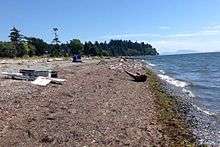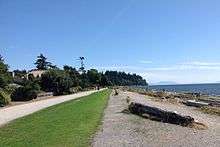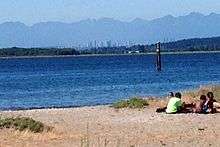Crescent Beach, British Columbia

Coordinates: 49°03′09″N 122°53′02″W / 49.052383°N 122.883947°W Crescent Beach is a beachside community within South Surrey, British Columbia next to Boundary Bay and Mud Bay across from Delta, British Columbia. It is home to 1,200 residents, mostly in single-family homes.[1]
History
Crescent Beach has been a summer destination for centuries. In pre-colonial times, it was the location of a significant temporary summer camp for area aboriginals. The tidal mudflats were a good clam digging area. Wild berries, especially cranberries, and a weir site were located at nearby Nicomekl River and Serpentine River areas. The area was part of Snokomish territory until a smallpox epidemic in 1850 forced the survivors and their lands to be amalgamated into the Semiahmoo First Nation.[2] Musqueam bands also travelled to use the lands seasonally.[3]
Artifacts such as arrowheads and jade have been found on the beach in the modern era.[4] First Nations' burial sites were uncovered in 1970 by sewer excavation.[3]
The Semiahmoo First Nation attributes three to five metres depth of the land base to archaeological deposits of clams, charcoal and fire-cracked rocks without which the area would largely just be a sandspit. Modern excavations in some parts have also uncovered more than 700 human remains.[5]
The first Europeans to chart the area were Spanish sailors. Captain Galiano titled it San Rafael Point on his map.[3]
After the creation of British Columbia, the first owner of Crescent Beach area was John Musselwaite of Royal Engineers in 1871.[3]
In 1909, development of the Great Northern Railway from Blaine, Washington to New Westminster provided easier access to the beach for Vancouver-area residents. In 1913, permanent dikes (now serving as the waterfront walkway) were established to permit subdivision development. In 1912, a pier was and the Crescent Beach Development Company promoted Crescent Beach as a resort area. Notable Vancouverites began building summer homes in the neighbourhood. That year, Captain Watkin Williams also opened the Crescent Beach Hotel, a 21-room building with a restaurant, store and post office. The hotel burned down in February 1950.[4]
Oysters imported from Japan seeded a thriving business for some decades until the Crescent Oyster Company was closed in 1961 due to river pollution and contemporary concerns about shellfish paralytic poisoning.[4]
Recreation

Crescent Beach is home to Alexandra Neighbourhood House, the Crescent Beach Pier and Blackie Spit Regional Park, all local landmarks. Crescent Beach is the home of the "Crescent Beach Swim Club", a local club that offers swimming, sailing, tennis, water polo, and triathlon lessons to kids.

On the southern end of Crescent Beach near the bottom of 101 steps staircase at 24th Ave. is the 120 tonne Crescent Rock boulder. Crescent Rock Beach is the 6.5 km. long rugged strip of shoreline from this large rock to White Rock at the base of the Ocean Park bluffs that is utilized by naturists and nudists for nude sunbathing and skinny-dipping. The City of Surrey refuses to endorse its clothing-optional use as it is outside their jurisdiction but the RCMP have acknowledged that nude use on this area out of sight from the marine parks at Crescent Beach and White Rock is legal under Canadian case law.[6]
The beach area has showers to wash feet and legs to prevent Swimmer's itch, a short-term immune reaction cause by waterborne parasites seeking Freshwater snails.[4]
Blackie Spit birdwatching

The northernmost portion of Crescent Beach is Blackie Spit, named after a settler and known as a birdwatching site beside Mud Bay and near Nicomekl River.[7] The City of Surrey created Blackie Spit Park in 1996.

The park is an annual migration rest stop for the Pacific Flyway for 300 species of birds including 10,000 ducks and geese. It is the only area in Boundary Bay where purple martins nest. The eelgrass meadows, mud flats and tidal marsh serve as bird habitats year-round. Shorebirds feed off biofilms, a paper-thin mucus, that consist of bacteria, diatoms (microscopic plants) and organic detritus.[8]
Transportation
Crescent Beach has a single road access (Crescent Beach Road) to the rest of Surrey which crosses the BNSF Railway. Implications for emergency access and impact of noise and coal dust from the trains are long-time concerns for residents.[9] From 2002 to 2014, the number of trains quadrupled from five to 20 a day.[1]
The 4.5 km Crescent Road corridor connects the beach area to King George Boulevard near Nicomekl River. The road is registered with the city and national historic place registries because it enabled transport to pioneer locations (such as Historic Stewart Farm) due to its first construction in 1882 shortly after incorporation of the City of Surrey.[10]
Beecher Street, known as the Marine Drive of Crescent Beach, is home to bistros, ice cream cafes and small stores.[7]
Boats are also stored at Crescent Beach Marina at the tip of Nicomekl River.
Arts & culture
A 2008 teen novel Reading the Bones by Gina McMurchy-Barber featured 12-year-old heroine Peggy Henderson uncovering an archaeological skull in her uncle's backyard in Crescent Beach.[11]
Scenes from the 2010 film Tron: Legacy were filmed along the waterfront at Crescent Beach, with one of the houses there functioning as the home of Kevin and Sam Flynn.[12]
In 2012, Shakespeare By The Sea began annual production of Shakespeare plays in August in open-ended tents similar to Vancouver's Bard on the Beach festival.[13]
See also
References
- 1 2 Reid, Amy (July 15, 2014). "Neighbourhoods: Crescent Beach is Surrey's 'hang ten' seaside village". The Now. Surrey, British Columbia.
- ↑ Brown, Jack (2012). "Semiahmoo Encampments". surreyhistory.ca. Retrieved 3 August 2014.
- 1 2 3 4 "Crescent Beach". City of Surrey. Retrieved 27 July 2016.
- 1 2 3 4 "Neighbourhoods: The history of Crescent Beach". The Now. Surrey, British Columbia. July 24, 2014.
- ↑ Don Welsh, manager archaeology services, Semiahmoo First Nation (August 5, 2014). "Letters: Beach history more extensive". Peace Arch News. White Rock, British Columbia.
- ↑ "Surrey's United Naturists". crescentrockbeach.org. Retrieved 3 August 2014.
- 1 2 Staff Writer (August 15, 2011). "Semiahmoo: Life's a beach". Surrey Leader. Retrieved 3 August 2014.
- ↑ Jack Christie (December 15, 2002). "A Day at Mud Bay". British Columbia Magazine.
- ↑ "Railing against coal trains". bclocalnews.com. March 20, 2013. Retrieved 3 August 2014.
- ↑ "Crescent Road". Canada's Historic Places. Retrieved 27 July 2016.
- ↑ Reading the Bones: A Peggy Henderson Adventure
- ↑ Peter T. Chattaway (June 18, 2012). "Farewell to Crescent Beach". patheos.com blog. Retrieved Sep 26, 2013.
- ↑ Browne, Alex (Nov 9, 2011). "Perchance to dream in Crescent Beach". Peace Arch News. Retrieved 3 August 2014.
External links
- Crescent Beach - City of Surrey
- Blackie Spit Park - City of Surrey
- "Crescent Beach". BC Geographical Names.
Surrounding neighbourhoods
 |
Delta Boundary Bay |
Colebrook Park Mud Bay |
Elgin Nicomekl River |
 |
| Boundary Bay | |
Crescent Heights Sunnyside, Surrey | ||
| ||||
| | ||||
| Boundary Bay | Ocean Park (Surrey) | Ocean Park White Rock |